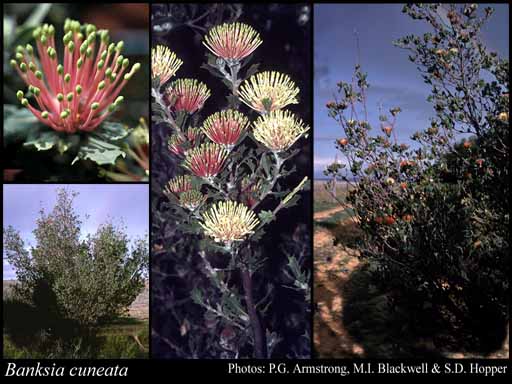- Reference
- Nuytsia 3:457-460 (1981)
- Conservation Code
-
Threatened
A taxon name retains its ‘Threatened’ status until a new name has been officially endorsed and appears in the Gazettal Notice.
- Naturalised Status
- Native to Western Australia
- Name Status
- Current
Non-lignotuberous, small tree or shrub, 2-4 m high. Fl. pink/pink & cream & yellow, Sep to Dec. Grey, yellow or yellow-brown sand.

Scientific Description
Shrubs, 2-3 m high; branchlets glabrous or hairy. Leaves petiolate, alternate, 10-40 mm long, 9-20 mm wide, hairy; petiole 0 mm long; lamina flat, clearly widest above the middle, once divided, pinnately divided, shallowly divided, teeth distinctly pointing towards the apex, with 2-5 lobes on each side, the margins revolute. Inflorescences tomentose (with matted or tangled, soft, woolly hairs), cream, yellow or pink; innermost bracts 4-6 mm long, hairy. Perianth 22-25 mm long, glabrous, without awns; pistil 23-25 mm long, straight, style glabrous. Follicles hairy, tomentose (with matted or tangled, soft, woolly hairs), ovate, 17-21 mm long. Flowers in September, October, November or December. Occurs in the South-west (SW) Botanical Province(s), in the Avon Wheatbelt (AW) IBRA subregion(s). : Conservation code Threatened (T).
Distribution
- IBRA Regions
- Avon Wheatbelt.
- IBRA Subregions
- Katanning, Merredin.
- Local Government Areas (LGAs)
- Brookton, Bruce Rock, Cuballing, Quairading.